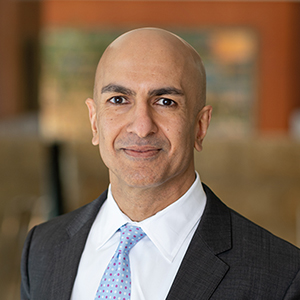This essay is also available on Medium.
On December 15, the Federal Open Market Committee (FOMC) released its latest Summary of Economic Projections (SEP), also known as the “dot plot,” which showed an increase in the median expected path of the federal funds rate over the next few years, relative to the prior SEP, which was published in September. My own submission to the SEP also showed an increase, from zero expected rate increases in 2022 in my September submission to two increases in December. This essay explains the data and considerations that led me to change my outlook for monetary policy.
In summary, while my baseline forecast remains that the high inflation consumers and businesses are currently experiencing will likely be transitory, I am putting more weight on the possibility that such transitory high inflation could nonetheless lead to an increase in long-term inflation expectations above our 2 percent target. Hence, I now believe the FOMC must balance what I see as two essentially opposing risks: 1) transitory high inflation leads to an increase in long-term inflation expectations, which then leads to sustained high inflation, and 2) once the COVID-19 shock finally passes, the economy returns to the low-growth, low-inflation regime it operated in for the 20 years prior to the pandemic.
If the FOMC were to allow long-term inflation expectations to become unanchored, it would then have to respond aggressively to re-anchor them at 2 percent, which could put the economy into recession, causing harm to families and communities. However, if the FOMC were to overreact to the current high inflation readings without realizing we were destined to end up back in the low-inflation regime, many Americans might have been needlessly prevented from participating in a recovery that was slower than necessary because monetary policy was too tight.
Given the remarkable uncertainty in the economic outlook and these two-sided risks to monetary policy, it is important that the FOMC remains data-dependent and that the public understands policy is not on a pre-set course.
My Analysis
As I have done in previous essays, I will begin my analysis by assessing our progress in meeting the dual mandate Congress has given us: price stability and maximum employment.
Price Stability
The FOMC has defined its price-stability mandate as inflation of 2 percent, using the personal consumption expenditures (PCE) measurement. Importantly, in our new monetary policy framework, we have indicated that we seek to average 2 percent inflation over time. We try to look at where inflation is heading, not just where it has been. Core inflation, which excludes volatile food and energy prices, is one of the best predictors we have of future headline inflation, our ultimate goal. For that reason, I also pay attention to the current readings of core inflation.
Chart 1 shows total and core PCE inflation for the past decade. The chart clearly shows that current inflation is substantially higher than it has been in recent years. While energy and food prices have driven headline inflation higher than core, core is nonetheless well above our 2 percent target. We know that these high inflation readings are driven by both demand and supply factors related to the pandemic, which I will elaborate on later in this essay.
Chart 2 shows market-based measures of inflation expectations, both over the next two years and from five to 10 years ahead. These indicators signal that investors expect inflation in the next two years to be substantially higher than its pre-pandemic level, but further out, once the COVID-19 shock is thought to have fully passed, investors expect inflation to return to its earlier level. Hence, these data do not suggest investors currently believe high near-term inflation is going to turn into high long-term inflation.
Chart 3 shows survey-based measures of inflation expectations, specifically the Survey of Professional Forecasters, both for the next five years and also the following five years. These measures show higher inflation expectations in the next few years, above the FOMC’s target, while longer-run expectations remain consistent with the Fed’s target.
Past inflationary cycles have tended to be global, with advanced economies all experiencing very high inflation in the 1970s and also low inflation in the two decades prior to the pandemic. This seems to be true once again. Chart 4 shows inflation in various advanced economies; while there are some differences in inflation levels across these regions, they are all moving up quickly. This is important, because it suggests the drivers of current increasing inflation are likely common across these economies, a point I will return to in the discussion of supply and demand.
Maximum Employment
Next, let’s look at our maximum employment mandate. The labor market recovery has made a lot of progress since the depths of the pandemic, but we are still 4 million to 5 million jobs short of where we should be had there been no COVID-19 crisis. While there are many different measures that we look at to assess the labor market, I will highlight a few here. Chart 5 shows both the employment-to-population ratio and the labor force participation rate for prime-age workers, those ages 25 to 54. These charts clearly show the strong bounce-back in the labor market over the past year, but they also show that a meaningful gap remains from a full recovery.
At the same time, there have been widespread complaints from businesses of worker shortages. While I’ve heard businesses complain of worker shortages for years—they tend to do so any time they can’t find skilled workers at wages they are used to paying—this current environment seems different, because by many measures, demand for workers appears to be outstripping the supply of workers. One way of assessing the balance between supply and demand in a market is to look at the price—which, in the case of labor, means looking at wages and compensation. Wages are now climbing rapidly across various income categories, with the highest increases for lowest-income workers. My conclusion from these data is that demand for labor has rebounded more quickly than the supply of labor, leading to an increase in wages and compensation.
This complicates my reading of where we are relative to maximum employment. The labor market has not fully recovered from the COVID-19 shock and I expect it eventually will. One of my lessons from the prior recovery is that the vast majority of Americans want to work if given the chance to get a decent job at a decent wage. But how long it is going to take for all prior workers to return is unclear. For now, at least, it appears demand for workers exceeds the supply of workers.
How Persistent Will High Inflation Be?
As noted above, I still believe the high inflation readings we are experiencing will be transitory, that they are being driven by both demand and supply factors related to the pandemic, and that once the COVID-19 shock is behind us (and those specific factors essentially go back to normal), inflation should return to pre-pandemic levels. Let us look at demand and supply individually.
Demand
In response to the pandemic and resulting shutdowns of portions of the global economy, many governments around the world enacted large fiscal-support programs to help businesses and families meet their financial obligations until economic activity could resume. In some cases (such as in the United States) the fiscal packages ended up being far larger than the income that was lost due to the pandemic, leading to a net stimulus of the economy relative to pre-pandemic levels. We also saw large savings accumulate among families in virtually all income categories, partly due to the stimulus just described, but also due to the fact that service industries were substantially disrupted, forcing families to save the money they otherwise would have spent on in-person services that were not available, such as travel. This reduction in services spending led to both an increase in savings and an increase in goods consumption, because producers of consumer goods were less disrupted.
This global stimulus and shift from services to goods have contributed to robust demand around the world and can help explain the high inflation many advanced economies are simultaneously experiencing. In fact, many of the sectors that have seen the largest increases in inflation, such as food, energy, automobiles, and some commodities, tend to be global markets. An increase in demand in one advanced economy can affect prices globally.
But this global fiscal stimulus and shift from services to goods should be temporary. Unless Congress passes additional fiscal stimulus, we know that the COVID-19-related spending packages in the United States are already winding down and what is currently stimulus will soon turn into a fiscal drag. We can estimate the accumulated excess savings of families by income level, and lower-income families already appear to be spending down their accumulated savings. And we are seeing a return of services spending as airports, hotels, and gyms have largely reopened and in some cases reached new records for traffic. While the new Omicron variant and future potential variants could delay the rebalancing of goods to services, there is little in the demand forecast that suggests high inflation should persist once the COVID-19 shock, and associated policy support, is fully behind us.
Supply
Many supply chains have been disrupted during the pandemic. In some cases, worker shortages have made it difficult for factories to run at full capacity or for shippers to meet demand. Global supply chains have been disrupted as factories in other countries have been shut due to local COVID-19 outbreaks. In other cases, supply chains are actually running at full capacity but demand has simply exceeded pre-pandemic levels, as noted above, and supply can’t keep up.
Some of these factors should be temporary. As vaccines continue to be adopted across the world, the global economy and global supply chains should become more resilient to future outbreaks. Similarly, as workers return to the labor market, both as fears of COVID-19 recede and as excess savings are spent, companies should find it easier to hire the workers they need.
But COVID-19 is a significant uncertainty. New variants such as Omicron or others could delay the full restoration of supply chains. Large global companies have indicated to me that their supply-chain problems do not appear to be getting better on the whole. Many report that as one issue is resolved, new issues emerge somewhere else. One company noted that because it is large and global, it is always dealing with supply chain problems, but is currently dealing with 10 times as many issues as is typical. When asked when they expect supply-chain issues to return to normal, most companies could only venture a guess: not in 2022 but maybe in 2023.
There seems less uncertainty in the outlook for elevated demand than in the outlook for disrupted supply. Even if demand returns to normal as policy support fades and consumers rebalance their spending toward services, inflation could remain elevated if supply-chain disruptions persist.
Two Opposing Risks: Likelihood and Costs
I believe the FOMC faces two opposing risks: 1) transitory high inflation leads to an increase in long-term inflation expectations, which then leads to sustained high inflation, and 2) once the COVID-19 shock finally passes, the economy returns to the low-growth, low-inflation regime it operated in for the 20 years prior to the pandemic.
Which outcome is more likely? What is the evidence so far of either?
-
The case for un-anchoring of inflation expectations. As noted above, short- and medium-term inflation expectations have increased and appear to be meaningfully higher than our target, but there is little evidence that long-term inflation expectations have climbed. A key question is: What is the mechanism by which a temporary boost of inflation, even for a few years, leads to a long-term increase of expectations?
There is tremendous uncertainty about this mechanism, but one area on which I have become focused is long-term wage agreements. In my discussions with large global companies, one noted a meaningful increase in the long-term wage increases it is negotiating with its unionized workforce. This company reported that prior to the pandemic, it would typically sign three- to five-year contracts at a 3 percent annual wage increase. Now it reports signing three- to five-year contracts at 7 to 10 percent annual wage increases. That is a stark example of how even transitory high inflation could lead to a sustained increase in inflation. Such feedback on labor agreements led me to look at other recent union contracts, and the return of cost of living adjustments (COLAs) appears noteworthy.
The next chart shows that the inclusion of COLAs in union contracts appears to be tightly linked to the inflationary environment. In the 1970s, most private sector union workers were covered by COLAs. By the 1990s, that percentage had fallen by two-thirds as both union power declined and as inflation (and inflation volatility) came down so such protection was less of a priority for workers.
Loading chart 7...Thus, it was notable that the recent John Deere contract reintroduced a COLA after having dropped it in 2015. While such labor developments may be good for workers, they could signal that short-term pressures are in fact leading to more sustained changes in costs that ultimately must be passed on to consumers via higher prices. I would also note, in contrast, that some labor union representatives indicated they were not seeing a marked difference in wage rates or other terms compared to prior to the pandemic.
-
The case for returning to a low-inflation world post-COVID-19. The FOMC’s recent framework review was motivated by falling neutral real interest rates, continuous and prolonged undershooting of our inflation target, and concerns about recurrent trips to the zero lower bound. The persistent, global, low neutral-rate environment that virtually all advanced-economy central banks have struggled with was driven by demographics, trade, and technology factors. It is unlikely that these underlying forces have gone away. In at least one case, demographics, the trends have only gotten worse, with less immigration into the United States as a result of the pandemic. Once the COVID-19 shock is past us, why won’t the U.S. economy return to this prior regime?
Indeed, markets have not bought into the story that we are entering a new, higher neutral-rate environment. It is notable that long-term nominal rates are still very low, with the 10-year Treasury rate at about 1.6 percent, despite surprisingly high inflation and the FOMC first starting, and then accelerating, its taper of quantitative easing.
What is the cost of these outcomes occurring?
- If we end up in a higher-inflation regime, then the FOMC will likely have to react more aggressively to re-anchor inflation expectations at 2 percent. The cost of that policy mistake will be borne by workers and families, first by them having to pay higher prices and having their real wages eroded, and then by the job losses from the recession that could follow. This is a very painful outcome that I certainly want to avoid.
- However, if we overreact to the near-term high inflation readings without realizing we were destined to end up back in the low-rate and low-inflation regime we had been in for 20 years, the recovery will have been needlessly slowed and we may have kept millions of Americans on the sidelines. These costs will also be borne by Main Street.
Pulling It All Together
I have a lot of confidence that the demand shock will soon subside, but I have less confidence in how quickly supply will return to normal. Fundamentally, I believe it is more likely we end up back in the low-inflation regime that we were in for 20 years than a new high-inflation regime. However, the costs of ending up in the high-inflation regime are likely larger than the costs of ending up back in the low-inflation regime. But we shouldn’t forget that there are significant costs with either error, and that those costs will likely fall on those Americans who can least afford to bear them.
If the macroeconomic forces that kept advanced economies in a low-inflation regime are ultimately going to reassert themselves, the challenge for the FOMC will be to recognize this as soon as possible so we can avoid needlessly slowing the recovery, while at the same time protecting against the risk of entering a new, high-inflation regime. This strikes me as an especially difficult challenge for policymakers.
How did this view affect my federal funds rate outlook? I supported the FOMC’s decision in December to increase the speed of tapering. Given the high inflation we are experiencing, this seemed like a prudent decision that provides flexibility in the future for raising rates sooner if necessary. I brought forward two rate increases into 2022 because inflation has been higher and more persistent than I had expected.
I would also note that in September of 2020 I dissented against the FOMC’s new forward guidance, because it requires the FOMC to make an independent assessment about the level of maximum employment, which proved difficult to do accurately in the last expansion. I preferred a simpler forward guidance that allowed core inflation to guide us as to when we had reached maximum employment. Specifically, I wanted to commit to keeping the federal funds rate at the effective lower bound until 12-month core PCE had exceeded 2 percent for 12 months. Once that condition had been met, we would know we were at maximum employment and we then would have the option of lifting off. With the high inflation readings over the past year, the test that I preferred will likely be met when the April 2022 data are released the following month (note it is a threshold for lifting off, not an immediate trigger). My recent SEP submission of two increases in 2022 is consistent with this threshold being met with the April data.
Assessing the level of maximum employment is once again proving difficult, with the supply and demand for workers recovering at different rates. Given our adopted forward guidance that we must both reach our inflation target and also achieve maximum employment before lifting off, the FOMC will likely soon have to make a judgment about the difference between a short-run level of maximum employment versus a long-run level. Those are each challenging assessments to make. Using core inflation to indicate when we have reached maximum employment may be simpler than the more judgmental estimations of short-run vs. long-run maximum employment.
I want to caution that interest-rate policy should not be on a pre-set course. As I described in this essay, I see remarkable economic and policy uncertainty. I will continue to pay close attention to both demand and supply dynamics, as well as inflation, hiring, wage trends, and labor agreements. As we get more data, I will have a better sense of where policy should go from here.




